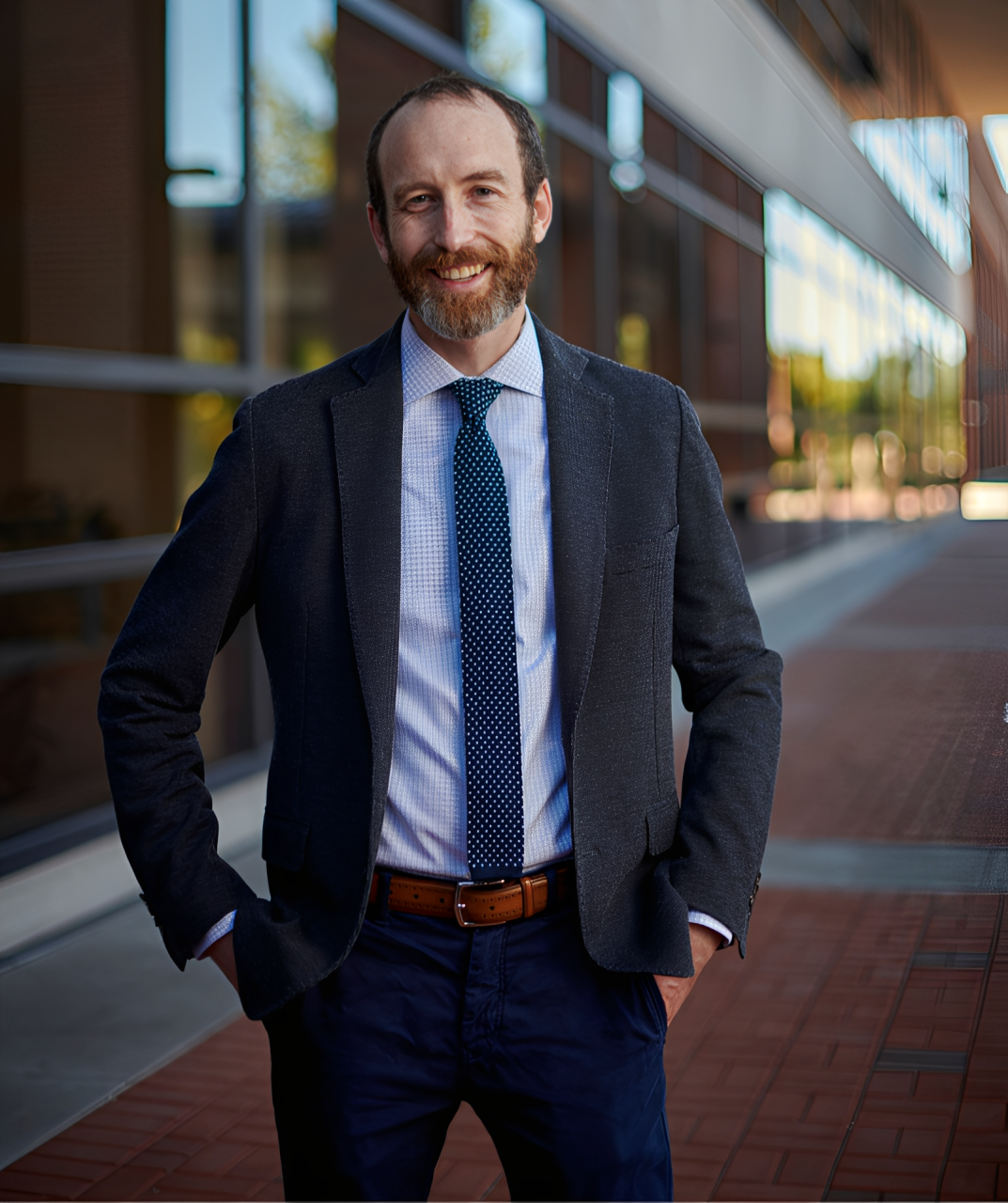Published August 8, 2025
A massive overhaul of America’s water systems is underway. Federal investments tied to the Bipartisan Infrastructure Law and Inflation Reduction Act are driving efforts to replace lead pipes, modernize treatment plants, and address new water quality goals.
That work is unfolding throughout Michigan, from major urban areas to smaller communities like Reed City, where state programs have supported over $35 million in water system upgrades since 2022.
As these efforts take shape, three MSU research teams are examining how Midwestern communities navigate water access and decision-making, from climate resilience to public attitudes and policy outcomes. Together, their work explores the challenges and tradeoffs of aligning broad water policies with diverse local needs in the pursuit of ‘water for all’—the UN SDG 6 framework for ensuring safe, affordable water for everyone.

Justin Simard, Assistant Professor at MSU College of Law.
Indigenous water stewardship and climate resilience
When MSU law professor Justin Simard and a multidisciplinary team of MSU faculty and students began collaborating with the Little Traverse Bay Band of Ottawa Indians (LTBB), their goal was to explore how technology could support the tribe’s response to climate change. The team, made up of experts in law, environmental science, and public policy, intended to focus on agriculture—specifically the LTBB’s 300-acre Ziibimijwang Farm in northern Michigan, which supports local food production.
But as they engaged more deeply with the tribe, their work expanded beyond farming to include declining fish populations, the shifting availability of medicinal plants, and cultural ceremonies disrupted by climate change.
“In hindsight it seems obvious that climate change is affecting all those things,” Simard said. “But the tribe helped us to understand not just the impacts, but how deeply important those things are to their community.”
What emerged was a layered understanding of how climate change can affect a community’s relationship with water, not just through infrastructure or agriculture, but through identity and tradition. For the LTBB, that relationship is reflected in everyday practices that depend on healthy water systems.
“One thing that kept coming up was fish,” Simard said, reflecting on a December 2024 workshop with the tribe. “The change in access to fish was significant.”
Since the 1600s, the LTBB have fished the Great Lakes and its surrounding waterways, relying on sturgeon, whitefish, and trout as a dietary staple and a source of trade. But in recent decades, those fish populations have become less accessible due to warming water temperatures, invasive species, and habitat disruption.
One workshop participant, a commercial and recreational fisherman since 1965, noted the steep decline in perch, trout, and whitefish—changes that have reshaped how, when, and where fishing takes place. “We keep taking away, but we can’t replenish,” he said. If that continues, the resource could be lost.
Similar disruptions have affected the harvesting of medicinal plants like cedar, birch, and sweetgrass, used during traditional healing and spiritual ceremonies. Shifting seasons and irregular rainfall have changed when and where they grow.
Understanding these changes, and approaching them with respect for cultural context, has required more than just data. One of the project’s key collaborators, MSU law professor Wenona Singel, is a member of the LTBB and director of the Indigenous Law and Policy Center. Her involvement has helped bridge the university’s research with the tribe’s priorities, fostering trust and ensuring that the work is grounded in collaboration rather than assumption.
Simard and Singel’s team is still working with the LTBB to understand their response to climate change. Their approach emphasizes conversation over prescription, recognizing that priorities emerge through dialogue and that new technologies are most useful when they can support, rather than replace, traditional practices.

Sampriti Sarkar, MSU PhD candidate in Agricultural Economics and Environmental Science and Policy Program.
Public support for water affordability and infrastructure programs
While Indigenous perspectives highlight deep cultural and environmental connections to water, other MSU researchers are examining how public attitudes and policy shape access and affordability.
MSU PhD candidate Sampriti Sarkar and Frank Lupi, professor of environmental and resource economics, shift the focus outward, from one community’s ties to water to the public’s willingness to support equitable access.
Using a choice experiment with over 1,700 residents in Michigan and Ohio, they explored public support for two water policies: replacing aging infrastructure and helping low-income households afford water. To understand what shapes public support, they included behavioral questions to measure altruism—because, as Sarkar explained, a person’s willingness to help others is likely to influence whether they’ll support an affordability program.
Sarkar and Lupi found that altruists were more willing to pay for a water affordability program than non-altruists. However, if they believed the program would encourage waste, they were even less willing to pay than those who expressed no altruistic preferences at all.
“There’s this notion that if someone gets water for free, they’ll end up using more of it,” Sarkar said. “But getting support through a water affordability program doesn’t mean getting free water. It means getting subsidized water.”
While Sarkar and Lupi’s survey found support for both infrastructure replacement and a water affordability program, 34% of respondents believed that assistance would lead to increased water use. 10% of respondents strongly believed that beneficiaries would waste water, 24% believed beneficiaries would probably waste water, and another 34% of respondents were unsure.
This tension, between supporting affordability and fearing misuse, reflects a larger pattern of paternalism in public policy, where public attitudes can be influenced by assumptions about recipients’ behavior or worthiness. SNAPpolicies offer a clear example, often debated and restricted based on fears that low-income recipients will misuse their benefits.
Sarkar explained that clearer public messaging can help shift these attitudes. She pointed to infrastructure replacement as one example.
“Infrastructure is largely invisible because it’s buried underground,” she said. “We don’t see most of the pipes or know what condition they’re in.”
She aimed to change that by making the consequences of aging systems more tangible, showing how deteriorating infrastructure can affect public health and the environment. That clarity, Sarkar said, helped shift support toward investment, making something abstract or detached, real and immediate. The same approach could help reduce the communication gap around affordability programs.
Sarkar’s next study will examine public awareness of PFAS and whether people are willing to pay for regular water testing. So far, just 40% of survey respondents have even heard of the contaminant, underscoring the need for broader public education. Like her work on infrastructure and affordability, this study uses behavioral insights to understand how people make decisions about emerging water concerns.
Taken together, Sarkar’s findings point to a central challenge in achieving water for all: translating collective values into informed public support.

Saesol Kang, PhD Student in the Department of Agricultural, Food, and Resource Economics.
Nutrient pollution and effective policy
Understanding public support is essential to designing effective water quality policies, but equally important is evaluating their real-world impact. MSU research on nutrient pollution offers insights into the effectiveness of these regulations.
MSU PhD student Saesol Kang and assistant professor Molly Sears, an environmental and resource economist, examined the long-term effectiveness of numeric phosphorus standards, or state limits on phosphorus levels in water designed to prevent nutrient pollution and protect water quality. Their study found that in states where these standards have been adopted, phosphorus concentrations were more likely to decline over time, suggesting that the policy can play a meaningful role in improving water quality.
While phosphorus is necessary for plant and crop growth, its overuse can lead to serious ecological consequences.
“When there’s too much phosphorus in rivers, it fuels algal blooms, which use up oxygen and harm fish or other aquatic life,” Kang explained. “These blooms also produce toxins that are dangerous to both humans and animals and can sometimes clog irrigation equipment or water intake systems.”
Because most phosphorus pollution comes from diffuse sources, like agricultural runoff and urban stormwater, it can be difficult to manage.
To investigate, Kang and Sears analyzed more than 100,000 phosphorus readings from over 28,000 monitoring stations across 32 states, using data from the EPA’s Water Quality Portal. Their 41-year dataset (1981-2021) compared rivers and streams that were regulated by numeric standards to those that weren’t, controlling for weather conditions and statewide socioeconomic changes. This approach allowed them to track changes over time and isolate the effect of the standards.
“When we focus just on the first nine years after adoption, we do see consistent improvement,” Kang said. During that period, phosphorus concentrations declined by 0.04 milligrams per liter, roughly a 16% reduction from the sample average.
These findings point to the effectiveness of numeric phosphorus standards. Still, their adoption for rivers and streams remains limited throughout the U.S. Only 13 states have adopted them since the EPA began encouraging numeric criteria in the 1990s. Many, including Michigan, continue to rely on narrative standards or TMDLs (Total Maximum Daily Loads)—approaches that are often less enforceable, and is applied more narrowly to specific waterbodies after impairment is identified.
Kang’s research underscores the gap between what science can demonstrate and what policy is willing to embrace. Bridging this divide requires practical solutions that balance effectiveness with political and economic realities.
Kang explained that numeric standards can improve the effectiveness of water conservation policies at a low cost. Once adopted, they provide a clear, science-based foundation for regulatory programs like the National Pollutant Discharge Elimination System, guiding permit limits for facilities that release pollutants and helping states manage water quality more efficiently.
Moving toward water for all
Collectively, the work of these MSU research teams highlight the multi-faceted challenges and opportunities in achieving water for all. From honoring Indigenous knowledge and cultural connections with water, to understanding public attitudes around affordability and infrastructure, to demonstrating the measurable impact of targeted nutrient pollution policies, each study reveals how science, policy, and community intersect.
Together, their findings underscore that improving water systems requires grounded science, clear policies, and attention to diverse local needs. As investments continue, success will depend on sustained collaboration between researchers, policymakers, and communities to implement evidence-based approaches that address real-world conditions across Michigan and beyond.
Story by Aja Witt

